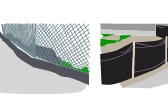
Most construction sites are cleared before work starts. For this reason, erosion can be a big problem and sediment running off construction sites can pollute waterways. Find out about sediment controls and how they work.

What are sediment controls?
Sediment controls are measures that help to prevent eroded soil from being carried off a building site into drains or waterways. Poor sediment control can be a big problem, polluting drains, local rivers and creeks, and creating serious issues with construction.
Sediment control may also involve erosion control meausres, which helps to prevent soil from being eroded in the first place.
What affects erosion?
The kinds of sediment controls that will be needed are normally determined by local council guidelines or regulations.
Generally speaking, the sorts of conditions that will affect what’s required in terms of sediment control include things like the slope of the land, the type of soil (clay vs. sand), how long work will take, how much rain is likely and how big and well vegetated the site is. Each of these conditions affects how dramatically erosion can occur, and each site is likely to have slightly different requirements.
What sorts of sediment controls exist?
There are several popular types of sediment controls used on building sites, including silt fences, fibre rolls, sand bag barriers, straw bale barriers and check dams. What’s required will depend largely on the site. Below is a brief description of the more commonly used systems:
Silt fences
Also known as ‘filter fences’ or ‘geotextile fabric sediment fences’. Silt fences are made from a woven mesh fabric (often made of polypropylene or something similar). Silt fences are normally erected around a runoff area. Silt fences work by allowing water to be filtered through, while trapping dirt and preventing it from running off the site.
Silt fences are normally supported either by timber stakes, or with a wire backing. This method is very popular because it’s so efficient, effective and easy to put up.
Straw bale sediment fences
Another sediment control method is to create a row of hay bales that are set into the ground slightly, and then stake each one in with two wooden posts. Water is filtered through the bales, while sediment is retained.
This method isn’t as effective for high volumes of runoff, although the bales can be reused later on the garden as mulch.
Silt socks
Also known as ‘sand sausages’, these are porous tubular ‘socks’ that are filled with sand, gravel woodchips or compost. that can be used to make a barrier that helps to filter and prevent sediment from running off the site.
Silt socks are reusable, and can be layered either directly on top of each other, in a pyramid formation to create a temporary wall, or at various stages on a slope to improve sediment control. Silt socks can also be used in conjunction with other methods like silt fences.
Filter trenches
A trench can be cut, where necessary, which acts to divert runoff from a flat, sandy site. Trenches normally incorporate a gravel filter at the end of the trench to capture sediment. Trenches are not appropriate for clay soils.
Aggregate perimeter fences
A wall of gravel or aggregate can be laid along in a line to help capture sediment in runoff from construction sites, although this too is only really appropriate for flat and sandy sites where runoff isn’t too bad.
How to prevent erosion once construction is finished
Once construction is complete, it’s important to finish the site in a way that helps to reduce the chance of erosion. The most obvious way to do this is to plant something – normally either lawns, shrubs or native vegetation. A good amount of mulch will also help to prevent runoff, as will things like biodegradable erosion mats used on steeper surfaces.
Paving and concreting can also be used to help retain the soil, although it can also reduce the amount of stormwater that’s absorbed into the earth, which creates other problems. For the best results it’s a good idea to landscape your garden (sloping areas in particular) with the appropriate vegetation, drainage and runoff in mind.





